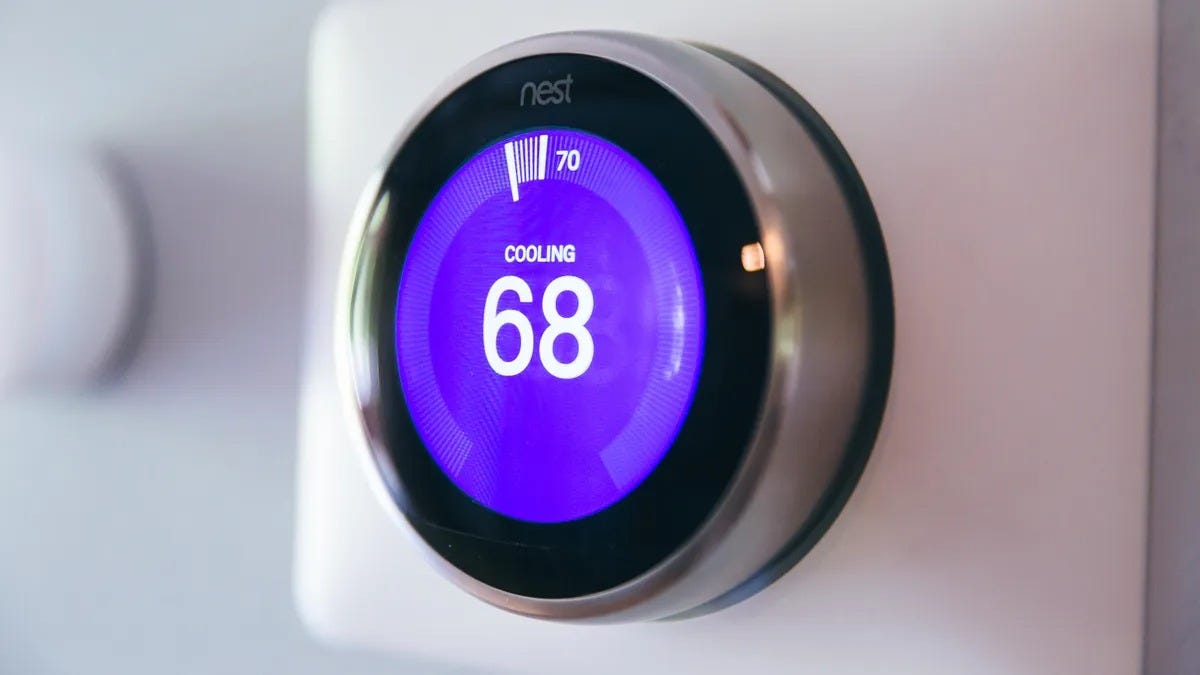A portable electric space heater, even multiple, will never heat your home the way a whole house heating system will. But one advantage space heaters have over baseboard or vented heat is precise localization. With energy costs high, we wondered if employing a space heater might allow you to crank down the thermostat and slash some money from your energy bill this winter.

To find out if space heaters are money-savers, we did math. While there are many variables including regional energy prices, energy type, climate, home size and target temperature, we relied on broad national averages to get our answer.
It turns out you can save hundreds, possibly thousands if you’re heating a bigger home with pricey oil. Don’t worry, we’ve shown all our work below like the good math students we are.
For more ways to save money this winter, check out five tips to save money on your heating bill, where you should move your thermostat to cut down heating costs and the best energy-saving smart gadgets that will help you cut down your bills.
How much does it cost to run a space heater?

With energy costs high, we explore space heaters as money-saving mechanism.
The cost to run a space heater depends on the type of heater that you’ve got, including its size and wattage. A small personal heater can be purchased as cheaply as $20, whereas a full-room heater can run you up to $300, depending on the model and heating capacity. Larger heaters cover more area and are more effective (while smaller heaters in big spaces are inefficient), but also cost more to run.
You’ll want to consider energy efficiency. This is tricky when it comes to space heaters because they are not currently evaluated by the Environmental Protection Agency’s EnergyStar program. As a result, you’ll have to take the word of the manufacturer.
Finally, you’ll need to take into account your state or municipality’s electricity rates. This will determine the cost per hour that you can expect to incur by running your space heater. These prices might also dictate how long you’d like to run your space heater.
On average, you can expect to pay about 20 cents per hour to run an average space heater that’s 1,500 watts and can heat a standard room. If you run it for eight hours per day, you’ll pay about $1.60 per day. That comes out to just under $50 per month.
How much does it cost to heat the average home?

Heating costs in the US regularly top $2,000 for a single season.
Comparatively, the cost to heat a house varies widely, based largely on home size and fuel type. Below is what the US Energy Information Association predicts US households will spend on heating this winter, from Oct. 1 through March 31 or 181 days. The chart of anticipated costs for various fuel types to heat a home in a climate 10% colder than the national average for winter 2022-23.
Projected US heating costs for winter 2022-23
| Cost per US household (Oct. ’22 – Mar. ’23) | Average price per day | Average price per hour | Increase from previous year | |
|---|---|---|---|---|
| Natural gas | $1,096 | $6.05 | $0.25 | 28% |
| Heating oil | $2,605 | $14.39 | $0.60 | 27% |
| Electricity | $1,482 | $8.16 | $0.34 | 10% |
| Propane | $2,157 | $11.90 | $0.50 | 5% |
Can you save on heating by using a space heater?

This chimney-style space heater adds warmth and ambiance.
While $50 per month sounds like a steal for heating, a space heater is not a full substitute for heating an entire home. But there are plenty of ways to save money using a space heater to supplement your monthly warming and slash your utility bill. If you think about it, home heating isn’t efficient since you’re not in all rooms at all times. A natural foil for a bloated heating bill is to crank the thermostat down and use a space heater to warm a room you know you’ll be in for an extended period such as your home office during the day or living room in the evening. For this exercise, we’ll calculate how much you could save using a space heater for a third of the day, or eight hours.
Using the figures in the first chart, I’ve calculated the average cost of running a space heater for eight hours versus the cost of running the heat for the entire home using each of the four most popular fuel types. I then multiplied the cost of each eight-hour total by 181 days (Oct. 1 to Mar. 31). From that, you can get a snapshot of the delta between the cost of running a space heater versus central heat, along with potential savings for using a space heater for a portion of the day.
How much you’ll save using a space heater
| Cost per 8 hours | Savings using space heater, 8 hours | Savings with space heater, Oct-Mar | |
|---|---|---|---|
| Natural gas | $2.00 | $0.40 | $72 |
| Heating oil | $4.80 | $2.80 | $506 |
| Electricity | $2.72 | $0.72 | $130 |
| Propane | $4.00 | $2.00 | $434 |
For those using oil or propane as fuel, the savings are significant: $434 for propane and $506 for oil just through the winter season alone. Those with natural gas and electric heat save less — $72 and $130, respectively — but, as you’ll see in the next section, these numbers don’t tell the entire story. Space heater savings are much greater for those with large apartments or freestanding homes and those who live in colder parts of the country.
Folks with larger homes save more with a space heater
One big caveat to these numbers for estimated heating costs is that they account for all homes and home types in the US including smaller apartments and condos. To heat an average freestanding home with natural gas, for instance, with a 75,000-BTU furnace, you’re probably looking at a number closer to 40 cents an hour, according to PickHvac’s heating cost calculator. And this is a yearly average; zeroing in on the winter season only would bounce that hourly cost more. The larger your home, the more it costs to heat and the greater your savings will be if you employ a space heater.
Those in colder climates will also save more, on average

Keeping the thermostat set at or below 68 degrees in winter is another way to trim costs from your energy bill.
The figures provided by the Energy Information Association are based on climates just 10% colder than the national average. The EIA numbers represent something of a rough estimate of US heating costs, but ask anyone in North Dakota, Maine or New Hampshire, and they’ll tell you these numbers are decidedly low. Anecdotally, we spoke with Deb Barber from Wakefield, Rhode Island, who uses oil to heat a 2,000-square-foot home and reported monthly winter heating bills regularly over $400.
If we use a lowball estimate of 60 cents per hour for heating a freestanding home of about 2,000 square feet with natural gas during the winter months in a colder climate, the savings for using a space heater for eight hours in place of central heat would jump to over $500 for the season. Swap in more expensive oil or propane and prorate for the same scenario above (a larger home or apartment and colder climate) and you’re talking about savings well into the thousands.
If you’re looking to add a space heater to cut energy costs, we’ve done some digging to find the best space heaters for 2024, including a budget pick, compact models and the best space heater for large rooms.
How do costs vary based on space heater settings?

The cost to run a space heater varies depending on its size and power.
On most space heaters, you’ll see an option to adjust the level of heat that the appliance provides. Most have some form of a “low,” “medium” and “high” setting. Typically what these settings translate to is the amount of the wattage capacity that is in use to heat your room.
Let’s say you have a space heater that can produce up to 1,500 watts and you place it on the “low” setting, it may only use 750 watts of its capacity. This does have an impact on the overall energy consumption that your space heater will require. It can cut the daily cost in half. However, it may limit the heating ability of the space heater. It might be best to use the low setting to maintain warmth and only use the medium or high settings to provide additional heat to save on cost.
Space heaters are handy appliances to have, especially as the weather outside gets frightful and you need to start layering your clothes. But you’ll want to prepare yourself for the cost of using a space heater. An additional $50 per month of utility costs can significantly impact your budget if you aren’t prepared for it. Consider how to best balance your budget and your heating needs to make it through the winter in comfort and without breaking the bank.
How to pick the right space heater

Most indoor space heaters are powered by electricity.
If you’re looking for some extra heat in the winter or to warm up your cubicle in a particularly cold office building, a space heater can be an excellent option. But not all space heaters are made the same. You’ll want to take into account the amount of space that you’re trying to heat, the way they heat the space, and the amount of energy they consume to perform the task.
For most people, a standard space heater that covers an average room will do the job. These cover about 200 square feet and are usually around 1,500 watts. If you’re looking to heat under a desk or a smaller space, a personal space heater with about 400 or 500 watts will do the job.
Two mains types to consider
Most space heaters fall into one of two types when it comes to generating heat. There are convection heaters, which work by heating coils that help to heat the air and spread it through the room with a fan. Then there are radiant heaters, which emit infrared radiation to help heat an area.
Radiant heaters are faster but more focused, whereas a convection heater provides more even heat throughout an area. In small bursts, radiant heaters are more efficient — but in a space that needs to be heated for an extended period, convection can prove to be more effective.
Whichever space heater you choose, make sure to check out our space heater safety guide.
If your utility relies on a time-of-use plan, learn more about peak and off-peak hours to save money. For more, check out the small home upgrade you can make that will save you big money on heating costs, and more easy ways to save money around the house.
Here Are 23 Ways to Save On Your Electric Bills Right Now
Editors note: This story was written in 2023. Energy costs are subject to fluctuation.




















+ There are no comments
Add yours